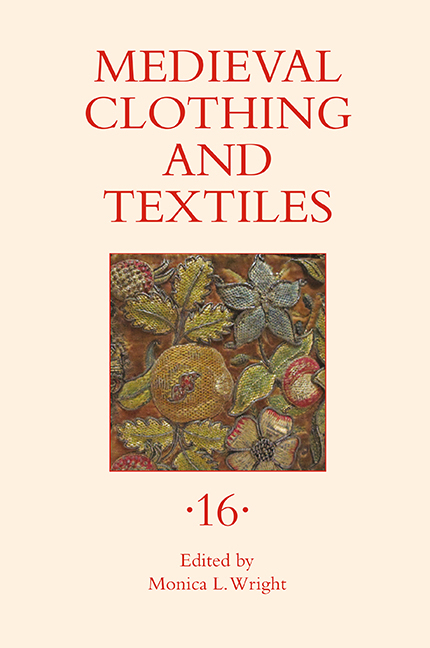Book contents
- Frontmatter
- Contents
- Illustrations
- Tables
- Contributors
- Preface
- 1 Anglo-Saxon Banners and Beowulf
- 2 The Use of Curved Templates in the Drawing of the Bayeux Tapestry
- 3 Construction and Reconstruction of the Past: The Medieval Nordic Textile Heritage of Hemp
- 4 Historicizing the Allegorical Eye: Reading Lady Mede
- 5 Sex, Lies, and Verdugados: Juana of Portugal and the Invention of Hoopskirts
- 6 Fashion and Material Culture in the Tabletop of the Seven Deadly Sins Attributed to Hieronymus Bosch
- 7 The Broderers’ Crown: The Examination and Reconstruction of a Sixteenth-Century City of London Livery Company Election Garland
- Appendix 7.1 Surviving Sixteenth-and Seventeenth-Century Embroidered Crowns of the City of London Livery Companies
- Recent Books of Interest
- Author Index, Volumes 1–15
1 - Anglo-Saxon Banners and Beowulf
Published online by Cambridge University Press: 27 March 2021
- Frontmatter
- Contents
- Illustrations
- Tables
- Contributors
- Preface
- 1 Anglo-Saxon Banners and Beowulf
- 2 The Use of Curved Templates in the Drawing of the Bayeux Tapestry
- 3 Construction and Reconstruction of the Past: The Medieval Nordic Textile Heritage of Hemp
- 4 Historicizing the Allegorical Eye: Reading Lady Mede
- 5 Sex, Lies, and Verdugados: Juana of Portugal and the Invention of Hoopskirts
- 6 Fashion and Material Culture in the Tabletop of the Seven Deadly Sins Attributed to Hieronymus Bosch
- 7 The Broderers’ Crown: The Examination and Reconstruction of a Sixteenth-Century City of London Livery Company Election Garland
- Appendix 7.1 Surviving Sixteenth-and Seventeenth-Century Embroidered Crowns of the City of London Livery Companies
- Recent Books of Interest
- Author Index, Volumes 1–15
Summary
The poem Beowulf is obsessed with treasures. The poet describes hoards in Hrothgar's hall Heorot, in Grendel's mother's underground hall, and in the dragon's hall under the mountain. Many episodes of the poem concern treasure exchange: Hrothgar builds Heorot in order to give treasures; he rewards Beowulf with magnificent treasures; Beowulf gives a sword to a coast guard; Beowulf and his king Hygelac exchange treasures; and the dying Beowulf gives treasures to his loyal thane Wiglaf and his people. Only a few treasures are specifically described, however, generally heirloom swords, and these descriptions usually concern their martial quality rather than their appearance: Hrunting, for instance, is decorated, but more importantly, has never failed in battle and Beowulf judges it to be a good sword, though it could not cut Grendel's mother. Yet the Beowulf poet gives pointed time and attention to segnas—banners or military standards. The first of these segnas is raised above Scyld Scefing's body on his funeral ship (47b). Hrothgar gives an heirloom banner to Beowulf as a reward for defeating Grendel; Beowulf later re-gifts this banner to his own king, Hygelac (1020–22a and 2152). Wiglaf finds the third prominent banner in the dragon's hoard (2767–71a). The poet mentions banners elsewhere briefly in important episodes of the feud between the Swedes and Geats (1202–07b; 2957b–60; 2500–2508a). In a poem that values treasures, but specifies very few, banners, like swords, are meant to be noticed.
The pointed and repeated mention of these banners, their association with royalty and gift-giving, and the detailed description of the dragon's banner argue that banners carried some cultural weight and textual importance. Yet, while Beowulf 's swords are often discussed in literary criticism, the banners have largely gone unstudied. Analyses of these banners, such as those by John Hill, Barbara Raw, and Cameron McNabb, consist of a few sentences in larger discussions of treasure. I have found little analysis of Anglo-Saxon banners in archeological or textile research—again, a few sentences based on primary literary and historical sources. Derek Renn's discussion of flags in the Bayeux Tapestry and Robert W. Jones's studies of banners and pre-heraldic military identification offer more information, but these studies focus on post-Conquest sources.
- Type
- Chapter
- Information
- Medieval Clothing and Textiles 16 , pp. 1 - 30Publisher: Boydell & BrewerPrint publication year: 2020



